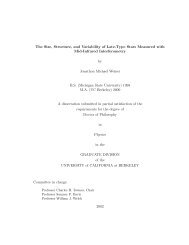Proc. of SPIE Vol. 7013 70130D-1 - The UC Berkeley Infrared ...
Proc. of SPIE Vol. 7013 70130D-1 - The UC Berkeley Infrared ...
Proc. of SPIE Vol. 7013 70130D-1 - The UC Berkeley Infrared ...
- No tags were found...
You also want an ePaper? Increase the reach of your titles
YUMPU automatically turns print PDFs into web optimized ePapers that Google loves.
Figure 5: An interference fringe signal <strong>of</strong> Orionis under exceptionally good seeing conditions.Atmospheric fluctuations are small enough that only very weak sidebands over a small fraction <strong>of</strong>one Hertz are produced by their variations. <strong>The</strong> Data were taken for 512 seconds, and the verynarrow resulting fringe has a width due primarily to this finite time <strong>of</strong> measurement 3Figure 6: An interference fringe from Orionis under very poor seeing conditions. In this casethe atmospheric pathlength is fluctuating severely and on timescales comparable with the inversewidth seen, or about 1/15 sec. This is fast for wavelengths as long as 11 μm. In spite <strong>of</strong> suchfluctuations, the fringe magnitude, or total power, can be rather accurately determined byintegrating the total power under the curve <strong>of</strong> this figure 3 .<strong>Proc</strong>. <strong>of</strong> <strong>SPIE</strong> <strong>Vol</strong>. <strong>7013</strong> <strong>7013</strong>0D-12












![Problem #1 [Structure Formation I: Radiation Era]](https://img.yumpu.com/37147371/1/190x245/problem-1-structure-formation-i-radiation-era.jpg?quality=85)



